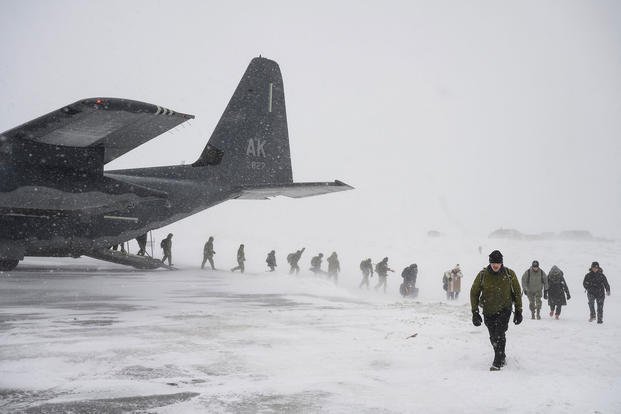
ANCHORAGE, Alaska — Military officials announced last week that Alaska’s Air National Guard will be indefinitely exempt from staffing changes that local leaders said would have devastated the force’s core operations.
For months, Alaska’s congressional delegation has been aggressively lobbying the National Guard Bureau to postpone or scrap an initiative known as “Fulltime Leveling,” which would have reclassified the job categories for about 80 members of the state’s Air National Guard beginning on Oct. 1.
“In numerous meetings, calls and letters, the Alaska congressional delegation strongly pressed Guard leaders to exempt Alaska from the planned cuts, highlighting the many unique missions of the Alaska (Air National Guard) that are critically important to U.S. homeland defense, including missile warning, aerial refueling, and combat rescue,” said a statement released by all three members the delegation.
The original directive, announced at the start of the year, is intended to more equitably staff all 54 of the country’s National Guard units. At its core, the initiative adjusts how states are allotted two different categories of full-time employees. On one side are Active Guard Reserve, or AGR, positions, which are equivalent to active duty airmen or soldiers in the regular military, and can be deployed for both state and federal missions, be it a natural disaster or a national security threat. Alaska has a higher share of such AGR positions within its National Guard that most other state Guard units because of the unusual mission set guardsmen are attached to, including search and rescue operations, around-the-clock radar monitoring, and aircraft refueling.
On the other side are Dual Status Technicians, federal civilian employees who are like full-time hourly employees and require more administrative procedures to switch between federal or state orders. Local officials have said the job category is poorly matched with many of the staffing requirements for the Guard’s work in Alaska, in part because so many operations require personnel maintain 24-7 alert status.
The proposal to swap 80 AGR positions within the Alaska Air Guard for 88 technicians set off alarm bells within the Alaska National Guard, which warned the change would degrade the force to the point of mission failure in a matter of months.
In April, the National Guard Bureau announced a one-year pause on implementing the leveling program in Alaska.
Now, that pause appears permanent.
“The AK ANG must be fully ‘excepted’ from the (Fulltime Leveling) initiative,” wrote Maj. Gen. Duke A. Pirak, acting director for the Air National Guard in an Aug. 20 letter addressed to Sen. Dan Sullivan.
The Alaska National Guard’s manning document, which lays out positions allotted to the unit, will not change in the upcoming fiscal year, but replicate the same number of AGRs assigned to Alaska as is currently on the books.
Pirak wrote that the Guard reached its conclusions in part after a two-day May visit to Alaska that was part of an analysis of potential impacts.
“The report concludes the AK ANG executes four missions above…requirements that are incompatible with Dual Status Technician (DST) resources,” Pirak wrote.
Not only would the conversion of AGR to technician positions been an organizational encumbrance, but many in the Guard said it would involve pay cuts so significant they would not be able to stay at their jobs. In a February meeting, several members told Sen. Lisa Murkowski the proposed changes would devastate their family finances and force them to look for other work. Guard leaders warned that dozens of departures by highly trained career airmen would create a cascade of negative impacts, hampering everything from ballistic missile monitoring to civilian search and rescues.
In March, according to Sullivan’s office, Pirak was tapped to take over at the head of the Air National Guard, a role that requires a promotion to the rank of lieutenant general. Over the summer, both senators added provisions and funding to the National Defense Authorization Act and Defense Appropriation bill that would boost the number of Air National Guard members.
And then came the arm-twisting.
At the beginning of August, Sullivan moved to block Pirak’s promotion “until Alaska is granted an exemption from the (Fulltime Leveling) initiative,” according to a statement from Sullivan’s office.
“As a member of the Senate Armed Services Committee, Sen. Sullivan uses targeted holds when needed to resolve major policy issues that would negatively impact military service members and U.S. national security,” the statement said.
Alaska’s indefinite exemption from the leveling initiative was greeted favorably by Maj. Gen. Torrence Saxe, who helms the force.
“The National Guard Bureau’s decision to exempt Alaska from their fulltime leveling initiative and reinstate 80 fulltime positions ensures the Alaska Air National Guard’s continued support of Alaska’s operational missions,” Saxe said in a brief statement.
___
©2024 Anchorage Daily News. Visit at adn.com. Distributed by Tribune Content Agency, LLC.
© Copyright 2024 Anchorage Daily News. All rights reserved. This material may not be published, broadcast, rewritten or redistributed.






